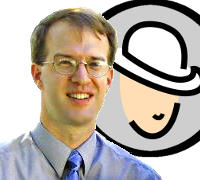When you purchase through links on our site, we may earn an affiliate commission (details)
How to Talk to the Brain’s Decision Making Center
If you don't know how to reach the part of a customer's brain that has the most power over their decisions, you're like a tree falling in the forest. Philosophers may spend weeks ruminating over whether you're making any noise. But if the decision maker isn't listening, you may make noise, but you won't make sales.
I've spent the past few days talking about how to reach customers' brains: through their habits or regular behavior patterns, and using video to influence them with vicarious experiences. Today, Michel Fortin pointed me to an article that attacks the question even more directly.
Over at SalesBrain is an article about 6 ways to talk to the "old brain", which is one of the parts of your brain that most powerfully influences your decisions.
The 'Old Brain' is Self-Centered
Your old brain is focused on survival, so it's all about you. That's not to say that it can't be influenced by things that benefit others, but it does mean that that has to be done indirectly (for example, by appealing to emotions through another part of the brain).
The 'Old Brain' Seeks Contrast
Your product can have all the benefits in the world, but if the customer doesn't see them as advantages over where they are right now, or over other alternatives, then why should it care? Michel Fortin talks about using Gap Analysis in your sales copy -- clearly pointing out the gap between where the customer will be with your product vs. without it. The Old Brain eats this stuff up.
The 'Old Brain' is Tangible
High-flying abstractions are wasted on this part of the brain. As I said in my review of Made to Stick, the more concrete you make your communications, the stickier and more influential they are. That's partly because making things concrete and tangible help you avoid talking over people's heads, but also partly because concreteness speaks to the brain's decision centers.
The 'Old Brain' Remembers Beginning and End
Maybe this is why, when listing benefits in a bullet list, you should put the best benefits first and last. Maybe this is why you need to restate benefits at the end of a sales letter.
The 'Old Brain' is Visual
Visual is more concrete than verbal. Visuals help induce vicarious experience. It all ties together. If you can find images that convey the meaning of your message -- particularly the benefits of your product, they'll give you a big leg up.
The 'Old Brain' Responds to Emotion
I'd guess that even if the Old Brain doesn't understand why you care about something, it does recognize whether you care, and takes that into account. If the rest of the brain doesn't care, maybe it's not important, right?
Anything you can do to create positive emotions around your product -- making the customer feel like part of a desirable community, appealing to social causes that they care about (showing that you care about and support the same causes as them, showing them how using your product will help them support the cause, etc.), giving them a positive vicarious experience, etc. -- will help you enlist the decision making force of the Old Brain.
These 6 points belong on a checklist that you use to evaluate your sales materials.




